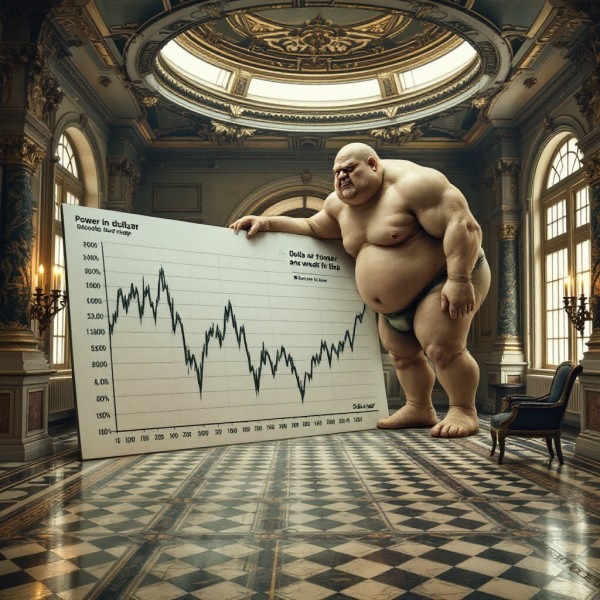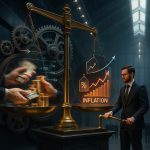Inflation Meaning: The Silent Tax That Erodes Wealth
Jan 14, 2025
“Inflation quietly siphons purchasing power from your pocket, often without fanfare—like a slow leak undermining financial stability.”
▌Introduction: The Inescapable Force at Play
People sometimes talk about inflation as an abstract phenomenon that only affects nations or large-scale economies. Inflation is a down-to-earth reality that touches each of us—and it does so silently. By chipping away at the currency’s value, inflation effectively shrinks what your money can buy over time, acting as a hidden tax on savings and disposable income. It doesn’t require a legislative process or a direct withdrawal from your bank account, yet it can erode your wealth just as surely as if a portion were routinely subtracted.
To what extent does inflation shape our daily choices? Consider the small things: the cost of groceries creeping upward or the monthly rent that seems to outpace pay raises. When these shifts happen slowly, they’re easy to ignore—until one day, we notice we’re paying much more for the same items. Understanding “Inflation Meaning” in practical terms matters because it determines how you approach saving, investing, or planning for retirement. Those unprepared to combat inflation risk watching their finances diminish in real value year by year.
▌Inflation Meaning: Definitions and Mechanics
In simple terms, inflation refers to the general increase in the prices of goods and services across an economy over a period. When inflation takes root, each currency unit—each dollar—buys fewer items or services today than it did yesterday. Though definitions vary, economists often measure inflation by tracking indices like the Consumer Price Index (CPI) or the Producer Price Index (PPI). These metrics collect data on common goods— from groceries and gasoline to medical services—and compare price changes over time.
But inflation isn’t just about items costing more. It has multiple ripple effects. Wages might rise in nominal terms but fail to keep up with the price growth, causing real incomes to stagnate or even decline. Borrowers might benefit if inflation outpaces the nominal interest on their debt, effectively lowering what they owe in real terms. On the other hand, savers and those living on fixed incomes, like many retirees, see their purchasing power dwindle when interest rates on savings lag behind inflation. The complexities revolve around how different economic players are positioned—lenders, borrowers, producers, or consumers.
Key drivers of inflation also vary. Traditionally, when a central bank injects too much money into the economy or keeps interest rates very low, the surge in available currency can fuel excess demand, pushing up prices. Supply shocks—such as sudden shortages of oil or agricultural produce—can also spark inflation as producers raise prices to cope with limited supply. Meanwhile, inflation sometimes ignites a self-perpetuating cycle: businesses pass on higher costs to consumers, who demand higher wages, prompting companies to increase prices further.
▌Why Inflation Acts Like a Silent Tax
When we think “tax,” we picture a clear method of collection—payroll taxes deducted from paychecks or sales tax added at the register. Inflation, by contrast, imposes costs indirectly. If you have $1,000 stashed under your mattress, that sum will buy fewer goods a year from now if annual inflation hovers around 5%. In effect, you’ve lost purchasing power without writing a check to any tax authority. Yet the result is comparable: you’re left with less real wealth than before.
This “tax” punishes the unprepared. People who fail to invest or hedge against inflation see their money gradually become less valuable. Imagine saving for retirement: if your returns don’t outpace inflation, the money you set aside each month could be unable to cover basic expenses down the road. That gap between nominal returns and inflation captures how stealthy—and damaging—this phenomenon can be. Savers in high-inflation environments often feel compelled to scramble for ways to preserve their wealth, whether by investing in real estate, precious metals, or inflation-protected securities.
Countries with runaway inflation highlight how dangerous it can get. In hyperinflationary episodes—like 1920s Germany or more recent cases in Venezuela—money can become nearly worthless in the span of months, forcing people to carry bundles of notes for a loaf of bread. While such extremes might be uncommon in well-developed nations, even moderate inflation over decades significantly drains wealth, especially if financial planning doesn’t account for it.
▌Impact on Savers and Retirees
One of the most direct casualties of inflation is the conservative saver who relies on bank deposits or bonds with a fixed rate. If a bank savings account yields 2% per year but inflation runs at 3%, the individual effectively loses 1% in purchasing power annually. Over decades, this gap compounds, meaning the real value of their nest egg erodes. Retirees living off fixed pensions or Social Security checks feel a similar squeeze every time prices rise faster than their income adjustments.
Longevity is another factor. As life expectancy climbs, a retiree might spend two or three decades in post-work life. Even low, persistent inflation can turn a comfortable pension into a source of daily worry if it no longer covers essential bills. Cost-of-living adjustments (COLAs) in pensions or social security can help, but they often lag or fail to match true living expenses fully. Moreover, certain items crucial to retirees—like healthcare—tend to experience price inflation above the overall average, intensifying the financial strain.
▌Businesses and Borrowers: Inflation’s Double-Edged Sword
Not everyone loses from inflation. Businesses that can pass higher input costs onto consumers maintain their profit margins. For instance, a food manufacturer facing increased commodity prices might raise its product prices. If demand stays stable, it can preserve or even expand profitability. However, if customers resist the hikes or competition undercuts the price, that advantage disappears, and the business may see margins squeezed.
Borrowers, such as homeowners with a fixed-rate mortgage, sometimes benefit if inflation outpaces the interest rate on their loan. Each scheduled payment becomes “cheaper” in real terms after a few years of inflation, meaning they repay with money that’s worth less than when they originally borrowed it. Conversely, lenders can face a devaluation of the principal they receive back over time unless they charge sufficiently high interest rates to account for inflation expectations.
Meanwhile, companies or countries with heavy debt loads can find these obligations less burdensome if nominal GDP—boosted partly by inflation—climbs faster than the interest they owe. This dynamic sometimes motivates governments to tolerate moderate inflation. But once inflation becomes unanchored and suspicion grows that policymakers have lost control, the resulting panic can lead to drastic economic hardship.
▌Policymakers and Central Banks: Balancing Act
Central banks play a vital role in shaping inflation through monetary policy tools like interest rates, open market operations, and quantitative easing. Their stated aim often includes keeping inflation moderate—enough to encourage spending and investment but not so high that it destabilizes the currency. In countries like the U.S., the Federal Reserve targets about 2% annual inflation, believing that some price increase correlates with healthy economic growth.
Yet hitting the “just right” range is hardly straightforward. If central banks tighten money supply too much, they risk a recession or deflationary spiral (where falling prices feed into reduced demand and wages). Conversely, inflation can surge past desired targets if they print money too freely or keep interest rates artificially low for too long. The delicate interplay of data forecasting, world events, and investor psychology means central bankers frequently face accusations of acting too late or overreacting.
Changes in fiscal policy—government spending and taxation—also impact inflation. Massive government stimulus, for instance, can pump money into an economy, raising demand and, occasionally, fueling price pressures. The synergy of monetary and fiscal policies must be finely tuned to keep inflation within a tolerable band.
▌Investing Wisely: Guarding Against the Erosion
How can individuals shield themselves from inflation’s corrosive effects? First and foremost, letting large sums of cash languish in a zero-interest checking account for extended periods is rarely advisable if you expect even modest inflation. Instead, keeping an emergency fund is wise, but beyond that, investing for returns above the inflation rate is key. Various strategies exist:
- Equities: Over the long term, well-managed companies can raise prices in line with inflation, helping preserve or grow shareholder value. Stocks aren’t immune to volatility, but historically, many equity markets have delivered returns that outpace rising costs.
- Real Estate: Property ownership stands as a traditional hedge, particularly when financed with a long-term fixed-rate mortgage. Rental income often climbs with inflation, and the mortgage debt effectively erodes over time.
- Inflation-Indexed Bonds: Certain government securities, like U.S. TIPS (Treasury Inflation-Protected Securities), adjust their principal to mirror inflation rates, ensuring the interest payments you receive maintain real value.
- Commodities: Assets like gold or broader commodity baskets can be a shield, particularly when central bank policies or supply shocks drive up prices. However, commodities can experience wild price swings, so caution is necessary.
- Diversification: Inflation’s paths are seldom linear or predictable. A balanced portfolio with exposure to multiple asset classes allows you to pivot as economic conditions shift.
The core point is that ignoring inflation in your investment plan amounts to leaving the door open for a steady theft of wealth. You’re effectively fending off this silent tax by proactively seeking assets and strategies that outpace inflation.
▌Behavioural Traps and Inflation Perceptions
Human psychology influences how severely we perceive inflation. When certain essential goods—like gasoline and eggs—rise in cost, we might talk about “out-of-control” inflation, even if overall prices are not surging dramatically. Conversely, a stable or slightly inflated cost for frequently purchased items may make us feel more at ease, even if other sectors of the economy are overheated.
The difference between official inflation numbers and the actual day-to-day experiences can create mistrust. People ask: “Why does the government say inflation is 3% if my groceries jump 10% each year?” The reality is that official measures rely on weighted baskets of goods, amortized costs (like housing), and sometimes complicated methodology. Meanwhile, personal inflation experiences vary with family size, location, and individual spending patterns.
This discrepancy also drives certain unhealthy behaviours—like panic buying or hoarding if one expects prices to skyrocket, which ironically can worsen real or expected inflation by boosting demand above supply. The interplay of perception and reality forms a feedback loop that policymakers struggle to manage, explaining why word choice in central bank statements can sway markets as much as interest rate decisions.
▌Deflation vs. Hyperinflation: Extremes of the Silent Tax
While moderate or persistent inflation is the usual scenario, deflation (falling prices) and hyperinflation (astronomically rising prices) represent opposite extremes with equally severe consequences. Deflation may appear beneficial at first—after all, who doesn’t like lower prices? But it often signals or triggers economic stagnation as consumers delay purchases, hoping prices drop further. Businesses see shrinking revenues, cut jobs, or fail entirely, creating a negative spiral.
Hyperinflation, on the other hand, is inflation gone berserk. Currencies can become nearly worthless within weeks. People lose trust in money itself, sometimes resorting to bartering for essentials. While advanced economies rarely encounter hyperinflation except in extraordinary circumstances (like major wars or governmental collapse), it underscores how currency stability is critical for everyday life. When that trust erodes, the entire economic system teeters.
▌International Ramifications: Currencies and Exchange Rates
Inflation in one country influences the attractiveness of its currency on the global stage. Higher inflation typically weakens a currency, as foreign investors require better returns to offset the loss in purchasing power. This can lead to fluctuating exchange rates, making imports more expensive and exports comparatively cheaper. For a country reliant on imported goods, inflationary pressures can accelerate if the domestic currency slides, as each imported item costs more in local currency.
Conversely, a robust currency can keep inflation subdued because imports become cheaper. Yet if that strength results from monetary tightening or other policies, it could hamper economic growth. Thus, each economy’s challenges with inflation can reverberate globally, impacting trade, investment flows, and the stability of emerging markets whose debts are often denominated in a major currency like the U.S. dollar.
▌Policy Debates: Is Some Inflation Good?
Economists often argue for a moderate level of inflation, suggesting it lubricates the wheels of commerce by encouraging spending and investment. If people believe prices will be slightly higher tomorrow, they’re more inclined to buy today, driving economic activity. Debtors also experience relief if nominal asset values rise. Yet “some” inflation can be subjective. A 2% annual target might feel comfortable, but what if real inflation spikes to 4% or 5%, or certain essentials rise even faster?
Moreover, persistent inflation beyond a narrow band can distort financial planning. Businesses become hesitant to commit to long-term projects if cost estimates are uncertain. Workers demand higher wages to keep pace with living expenses, risking wage-price spirals. Governments may juggle short-term political gains against long-term inflationary consequences, undermining population trust.
Ideally, policymakers aim for stability. While never perfect, price stability fosters confidence in the currency and the reliability of future returns. A well-informed public that understands “Inflation Meaning” will track whether policymakers truly keep that goal in sight or if short-term fixes override prudent long-term measures.
▌Conclusion: Defending Against the Silent Tax
Inflation acts like a continuous undercurrent, eroding the foundation of wealth if unaddressed. When its effects become painfully obvious—prices steeply higher, the mortgage less manageable, savings withered—an individual may find themselves scrambling for solutions. A proactive outlook is key: incorporate inflation projections into your financial decisions, monitor monetary policy, and choose investment vehicles that shield or outperform rising prices. In sum, don’t let the subtlety of inflation lull you into complacency. Recognizing it for what it is—a silent tax—lights the path toward more robust wealth preservation and growth.
How is Inflation Bad for the Economy? Let’s Start This Torrid Tale













